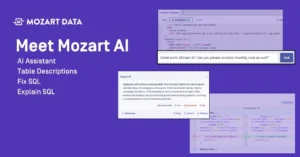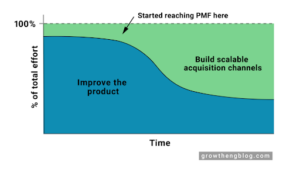Data modeling can help you employ stronger databases, making data collecting and processing easier and quicker than your competitors, but lots of companies are on that train these days. Read on to find out how your company can use data modeling to make good financial choices, develop marketing campaigns, and devise any other strategy.

What Is Data Modeling?
The act of generating a visual representation of an entire information system or parts of it in order to express linkages between pieces of data and structures is known as data modeling. The purpose is to show the different types of data that are used and saved in the system, as well as the links between them, how the data can be categorized and arranged, and its formats and features.
Data models are created to meet the needs of businesses. Regulations are developed ahead of time based on stakeholders’ feedback, so they may be included in the development of a new system or altered in a current one’s iteration.
At many degrees of abstraction, information can be modeled. The process starts with stakeholders and end-users providing data about business needs. These business principles are then converted into data structures, which are used to create a specific database design. A data model is similar to a roadmap, an architect’s plan, or any other formal layout that helps people comprehend what they’re designing.
Defined schemas and formal procedures are used in data modeling. That creates a standardized, consistent, and repeatable method of defining and controlling data resources across a business or even further.
Data models should, in theory, be live documents that change as business needs grow. They are crucial in supporting business operations as well as developing IT infrastructure and strategy. Partners, suppliers, and industry peers can all benefit from data models.
Why Is Data Modeling Important?
-
It guarantees that all of the database’s data objects are appropriately represented. The absence of data will result in defective reporting and inaccurate outcomes.
-
These models aid in the conceptual, logical, and physical architecture of the database.
-
Its structure aids in the definition of relational tables, main, external, and stored procedures.
-
It gives system developers a clear image of the basic data and can be utilized to establish a physical database for gaining business intelligence.
-
It can also be used to find data that is redundant or missing.
Although this initial design of a data model is labor-intensive and time-consuming, it will save you money and effort in the long run when it comes to upgrading and maintaining your IT architecture.
What Are The Types Of Data Modeling?
Information and database system design, like any other design phase, starts with a high level of abstraction and gradually gets more precise and specific. Data models are classified into three types based on the level of abstraction they provide.
Starting with a conceptual model, the procedure will advance to a logical model and then to a physical model. The following sections go through each type of data model in further depth:
Conceptual Data Models
They’re also known as domain models, and they provide a huge view of the system’s contents, how it’ll be organized, and which business processes will be involved. Typically, conceptual models are generated as part of the early project requirement analysis process.
Entity classes (which define the types of items that are significant for the company to describe in the data model), their features and limitations, their relationships with applicable security, and data integrity needs are typically included. Any notation is usually straightforward.
Logical Data Models
These are less abstract and offer more information on the patterns and relations in the domain. It is just one of the rigorous data modeling systems. They show the relationships between entities as well as data properties such as types of data and their respective lengths. Technical system needs are not specified in this data model.
In agile or DevOps techniques, this phase is frequently skipped. In highly operational implementation contexts or for initiatives that are data-oriented, such as monitoring systems integration or data warehouse design, logical data models might be valuable.
Physical Data Models
They define the format in which information will be physically stored, in this case, in a database. As a result, they’re the least conceptual of the bunch. These models provide a finished design that can be executed as a relational database, complete with associative tables that show the associations between entities as well as the main and foreign keys that will be utilized to keep those relationships up to date.
Physical data models might incorporate attributes related to a DBMS (database management system), such as performance tweaking.
Benefits Of Data Modeling
It is important to know all the benefits that data modeling can provide us by effectively implementing data models.
Recognize and Enhance Business Operations
Data modeling challenges you to describe your company’s operations in a way that allows several people to contribute. You can’t identify your data or what it does if you don’t understand how your business works.
To establish a user database, for example, you must first analyze the data your company presently has on clients and how it is being used.
As a result, data modeling reveals your data and its connections, laying the groundwork for understanding and improving your business operations.
Scalability
Databases that are well-designed can be expanded quickly. Your data processes will help your business as it grows, thanks to data modeling. Your requirements determine the best data model for your organization. You may improve your business by using a variety of modeling techniques.
Improved Cooperation
The IT staff can now work more readily with non-technical employees. They can interact in a technology-agnostic way utilizing data models but with enough information to generate actual data structures when required.
Data modeling facilitates the integration of elevated business operations with data rules, database systems, and the technical execution of physical data. Data models bring your company’s operations and data usage together in a way that everyone can comprehend.
Reduce Costs and Accelerate Time to Value
Enterprise customers could have a direct involvement in designing essential business rules via data modeling, which means fewer adjustments are required during implementation.
The convergence of needs and development reduces overall production time by a significant amount. That means you’ll be able to get projects and innovative products to market faster. We assisted one client in reducing their production period from 9 to 3 months by using data modeling.
Data modeling will also save you money because it detects problems immediately. This means fewer revisions are required, and your group is less likely to pass on error-prone projects to higher-ups or your consumers. As a result, data modeling can save you up to 75% on your development expenditure.
Data modeling is time-consuming and involves some effort. But it’s also one of the most effective ways to get control over your data, cut costs, and speed up production.
Decrease the Amount of Complexity and Danger
To deal with the tidal surge of data that every business must contend with, make sure your data is straightforward and low-risk. The more information you collect, the sooner you should consider taming it. And, given the numerous data compliance concerns that all firms confront, you must do it correctly. That entails recording and linking everything to the constantly changing data.
Data models are visual representations of your data operations that give you complete visibility into your data infrastructure. This decreases risk because you gain visibility into all of your data. Metadata, transformations, and filters are no longer hidden and dispersed. It’s now simple for your company to obtain a single version of the truth.
Data modeling also makes difficult, highly specialized aspects of your organization more approachable to non-technical employees like corporate leaders and C-suite managers.
Incorporating Your Data Models into Your Workflow
You can obtain complete control of data boundaries and metadata with the correct data modeling method. Then you may make use of all the advantages we’ve discussed.
Implementing these data definitions into action, on the other hand, takes a little more effort. You’ll need the means to convert textual structures into executable code to fill the gap between data integration and data modeling.
Data Modeling Tools: Start With Excel/Sheets (Nosql, Mongodb)
Excel can analyze mounds of data, but if you’re not using the Data Modeling function to organize it, you’re probably working incredibly hard. Now, certain solutions allow you to simply carry out that operation by storing the data in a database. These programs can design a database using diagrams, allowing you to get the design you need.
Several free open source data modeling tools are available. However, we will show you some options that will allow you to work with NoSQL and/or MongoDB:
DbSchema
It’s a database builder and manager that works with SQL, NoSQL, and Cloud databases. This application allows you to graphically design and engage with database schemas, collaborate on model design and deployment across many databases, create HTML5 diagram references, visually capture information and construct queries, and much more.
erwin Data Modeler
This data modeling tool goes beyond merely establishing the data model and enables continuous integration with databases like MySQL and PostgreSQL so you can view and make the most of your information.
-
Model development and deployment are included in the base edition.
-
The navigator edition is a read-only version designed to aid in data visualization.
-
The workgroup adds model administration and modeler collaboration services.
The most specific tool we can find, however, is the NoSQL version, which, as its name implies, works with non-relational databases.
Moon Modeler
Moon Modeler is a relational and NoSQL database data modeling tool. MongoDB, PostgreSQL, MySQL, GraphQL, and other technologies are supported.
Data Modeling Techniques
Hierarchical Technique
A tree-like architecture characterizes the hierarchical model. There is only one core node, and the other intermediate nodes are arranged in a specific order. However, the hierarchical paradigm is no longer widely utilized. For actual model connections, this technique can be employed.
Network Technique
The network model allows us to represent items and interactions between them in a variety of ways. It has a design feature that describes the data in the form of a diagram. An element is expressed inside a node, and the relationship between them is manifested as an edge, allowing for the universal management of numerous parent and child data.
Object-Oriented Technique
The generation of variables that contain values stored is the object-oriented technique. Data abstraction, encapsulation, and inheritance are all supported by the object-oriented model.
Relational Technique
The term “relational” is used to analyze the different relationships that exist between the objects. There are various types of relationships among entities, including:
-
One-to-one
-
One-to-many
-
Many-to-one
-
Many-to-many
Entity-Relationship Technique
The ER model (Entity-Relationship Paradigm) is a high-level relational model for defining data pieces and relationships for system entities. This conceptual design gives us a better summary of the system, making it easier to comprehend.
The complete database is presented in this paradigm by an entity-relationship graph, which is made up of Entities, Properties, and Relationships.
How Can Mozart Data Help by Combining It in One Place?
Mozart Data helps you to consolidate data from every one of your eCommerce platforms in one place. There will be no more data discrepancies or time lost scouring numerous platforms for the information you require.
Mozart Data can build dashboards and reports tailored to your company’s objectives and aspirations using all of your linked sources of data. These dashboards will help track results in real-time throughout your tools, including email and ad campaign performance, CAC and LTV for all of your acquisition channels, and conversion funnels.
You will be able to use your data in this manner to make successful and timely business decisions that will help you build your e-commerce firm. You’ll be able to quickly integrate new data sources into your Mozart account as you add more tools to operate your business.
You must do research that incorporates important data from all of your instruments. For the majority of eCommerce businesses, this entails merging data from marketing and advertising, website/app analytics, social media, point of sale, and customer service platforms. Making a great system that integrates all of your data, on the other hand, can be unpleasant, time-consuming, and expensive.
Mozart Data saves you time by automatically pulling information from all of your company’s platforms. It will also save you the time and effort of determining where to keep your data so that a uniform analysis can be performed throughout your entire organization. Too often, the results of one team are drastically different from those of another simply because their data source is inconsistent.
You can only obtain a deeper insight into your clients and the true success of your acquisition channels by merging data sources.


